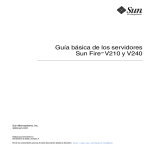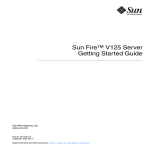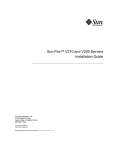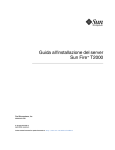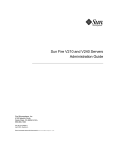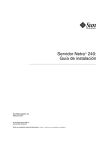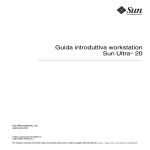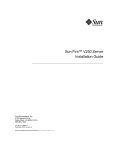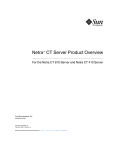Download Sun Fire V210 and V240 Servers Getting Started Guide
Transcript
Sun Fire™ V210 and V240 Servers Getting Started Guide Sun Microsystems, Inc. www.sun.com Part No. 819-4206-10 November 2005, Revision A Submit comments about this document at: http://www.sun.com/hwdocs/feedback Copyright 2005 Sun Microsystems, Inc., 4150 Network Circle, Santa Clara, California 95054, U.S.A. All rights reserved. Sun Microsystems, Inc. has intellectual property rights relating to technology that is described in this document. In particular, and without limitation, these intellectual property rights may include one or more of the U.S. patents listed at http://www.sun.com/patents and one or more additional patents or pending patent applications in the U.S. and in other countries. This document and the product to which it pertains are distributed under licenses restricting their use, copying, distribution, and decompilation. No part of the product or of this document may be reproduced in any form by any means without prior written authorization of Sun and its licensors, if any. Third-party software, including font technology, is copyrighted and licensed from Sun suppliers. Parts of the product may be derived from Berkeley BSD systems, licensed from the University of California. UNIX is a registered trademark in the U.S. and in other countries, exclusively licensed through X/Open Company, Ltd. Sun, Sun Microsystems, the Sun logo, Sun Fire, Java, OpenBoot, and Solaris are trademarks or registered trademarks of Sun Microsystems, Inc. in the U.S. and in other countries. All SPARC trademarks are used under license and are trademarks or registered trademarks of SPARC International, Inc. in the U.S. and in other countries. Products bearing SPARC trademarks are based upon an architecture developed by Sun Microsystems, Inc. The OPEN LOOK and Sun™ Graphical User Interface was developed by Sun Microsystems, Inc. for its users and licensees. Sun acknowledges the pioneering efforts of Xerox in researching and developing the concept of visual or graphical user interfaces for the computer industry. Sun holds a non-exclusive license from Xerox to the Xerox Graphical User Interface, which license also covers Sun’s licensees who implement OPEN LOOK GUIs and otherwise comply with Sun’s written license agreements. U.S. Government Rights—Commercial use. Government users are subject to the Sun Microsystems, Inc. standard license agreement and applicable provisions of the FAR and its supplements. DOCUMENTATION IS PROVIDED "AS IS" AND ALL EXPRESS OR IMPLIED CONDITIONS, REPRESENTATIONS AND WARRANTIES, INCLUDING ANY IMPLIED WARRANTY OF MERCHANTABILITY, FITNESS FOR A PARTICULAR PURPOSE OR NON-INFRINGEMENT, ARE DISCLAIMED, EXCEPT TO THE EXTENT THAT SUCH DISCLAIMERS ARE HELD TO BE LEGALLY INVALID. Copyright 2005 Sun Microsystems, Inc., 4150 Network Circle, Santa Clara, Californie 95054, Etats-Unis. Tous droits réservés. Sun Microsystems, Inc. a les droits de propriété intellectuels relatants à la technologie qui est décrit dans ce document. En particulier, et sans la limitation, ces droits de propriété intellectuels peuvent inclure un ou plus des brevets américains énumérés à http://www.sun.com/patents et un ou les brevets plus supplémentaires ou les applications de brevet en attente dans les Etats-Unis et dans les autres pays. Ce produit ou document est protégé par un copyright et distribué avec des licences qui en restreignent l’utilisation, la copie, la distribution, et la décompilation. Aucune partie de ce produit ou document ne peut être reproduite sous aucune forme, par quelque moyen que ce soit, sans l’autorisation préalable et écrite de Sun et de ses bailleurs de licence, s’il y en a. Le logiciel détenu par des tiers, et qui comprend la technologie relative aux polices de caractères, est protégé par un copyright et licencié par des fournisseurs de Sun. Des parties de ce produit pourront être dérivées des systèmes Berkeley BSD licenciés par l’Université de Californie. UNIX est une marque déposée aux Etats-Unis et dans d’autres pays et licenciée exclusivement par X/Open Company, Ltd. Sun, Sun Microsystems, le logo Sun, Sun Fire, Java, OpenBoot, et Solaris sont des marques de fabrique ou des marques déposées de Sun Microsystems, Inc. aux Etats-Unis et dans d’autres pays. Toutes les marques SPARC sont utilisées sous licence et sont des marques de fabrique ou des marques déposées de SPARC International, Inc. aux Etats-Unis et dans d’autres pays. Les produits portant les marques SPARC sont basés sur une architecture développée par Sun Microsystems, Inc. L’interface d’utilisation graphique OPEN LOOK et Sun™ a été développée par Sun Microsystems, Inc. pour ses utilisateurs et licenciés. Sun reconnaît les efforts de pionniers de Xerox pour la recherche et le développement du concept des interfaces d’utilisation visuelle ou graphique pour l’industrie de l’informatique. Sun détient une license non exclusive de Xerox sur l’interface d’utilisation graphique Xerox, cette licence couvrant également les licenciées de Sun qui mettent en place l’interface d ’utilisation graphique OPEN LOOK et qui en outre se conforment aux licences écrites de Sun. LA DOCUMENTATION EST FOURNIE "EN L’ÉTAT" ET TOUTES AUTRES CONDITIONS, DECLARATIONS ET GARANTIES EXPRESSES OU TACITES SONT FORMELLEMENT EXCLUES, DANS LA MESURE AUTORISEE PAR LA LOI APPLICABLE, Y COMPRIS NOTAMMENT TOUTE GARANTIE IMPLICITE RELATIVE A LA QUALITE MARCHANDE, A L’APTITUDE A UNE UTILISATION PARTICULIERE OU A L’ABSENCE DE CONTREFAÇON. Please Recycle Contents Servers Overview 1 Server Installation Process Site Preparation 2 4 Physical Specifications 4 Environmental Requirements 5 Recommended Operating Environment Airflow Considerations Acoustic Noise 6 6 Operating Power Limits and Ranges 7 Calculating Power Consumption 7 Calculating Heat Dissipation Shipping Kit Contents 7 7 Power Inlets and I/O Ports Power 5 8 9 Ethernet Ports Serial Ports USB Ports 9 9 10 External SCSI Port Preinstalled Software 10 10 1 OpenBoot PROM Diagnostics 11 Sun Advanced Lights Out Manager 11 Sun Fire V210 and V240 Documentation 12 Other Documentation, Support, and Training Third-Party Web Sites 13 Sun Welcomes Your Comments 2 13 Sun Fire V210 and V240 Servers Getting Started Guide • November 2005 13 Introducing the Sun Fire V210 and V240 Servers This guide provides you with a starting point for understanding the scope of the November 2005 release of the Sun Fire™ V210 and V240 servers. This guide also includes links to the resources available with these servers, instructions for planning the installation of a Sun Fire V210 or V240 server, and information for locating the cable connections, configuring the server and preinstalled software, and finding more information about these servers. Servers Overview The Sun Fire V210 and V240 servers are both UltraSPARC® IIIi based machines that are rackmountable. Both servers come with the Solaris™ 10 Operating System (OS), the Java™ Enterprise System, and the Advanced Lights Out Manager software preinstalled as a software image on the boot drive. Both servers feature four Gigabit Ethernet ports, one 10BASE-T Ethernet port for ALOM, two serial ports, two USB ports, one UltraSCSI LVD port, and up to 16 gigabytes of memory. The servers have the following differentiating features: TABLE 1 Server Differentiating Features Sun Fire V210 Sun Fire V240 Height 1 rack unit 2 rack units CPUs 1 or 2 1 or 2 1 TABLE 1 Server Differentiating Features (Continued) Sun Fire V210 Sun Fire V240 PCI expansion 1 3 Hard disk bays (SCSI) 2 4 Power supplies 1 2 (redundant) For a detailed list of features, available configurations, and compatible options, go to: http://www.sun.com/servers/ For detailed information about these servers, go to: http://sunsolve.sun.com/ See: Sun System Handbook Server Installation Process This section contains a list of tasks that you must complete during the installation process. Each task includes a reference to the appropriate instructions. Each task must be completed in order. 1. Preparing the site according to the power, clearance, and environmental requirements. If you are installing the server into a new Sun™ rack, you must fully prepare the site for the installation. If you are installing the server into an existing rack, you must conduct some site preparation to satisfy the additional power and environmental requirements. See “Site Preparation” on page 4 for specific instructions. 2. Verifying that you have received all of the components. The Sun Fire server ships in several packages. See “Shipping Kit Contents” on page 7 for a list of the shipping kit. 3. Installing the server into the rack. The installation of the rack slides and cable management arm (CMA) represent the majority of physical work during the installation. This release of the Sun Fire servers includes new rack slides, so the slide installation differs greatly from prior 2 Sun Fire V210 and V240 Servers Getting Started Guide • November 2005 releases. In addition, the Sun Fire V210 and V240 Servers Installation Guide replaces the rackmounting instructions that shipped with prior Sun Fire V210 and V240 servers. 4. Installing the optional components, if any, shipped with your server. To install optional components, refer to the Sun Fire V210 and V240 Servers Administration Guide for instructions. 5. Setting up a console to communicate with the server. You can communicate with the Sun Fire server using either a Tip connection from another server or an ASCII terminal connected to the SERIAL MGT port. To set up the console, refer to the Sun Fire V210 and V240 Servers Installation Guide for instructions. 6. Powering on the server and configuring the preinstalled software. The Solaris OS and the Java Enterprise System is preinstalled on the server. When you power the server on, you will automatically be taken through the Solaris OS configuration procedure. However, you must first go to the preinstalled software site for the latest updates and patches. To power on the server and configure the preinstalled software, refer to the Sun Fire V210 and V240 Servers Installation Guide for instructions. 7. Setting the desired OpenBoot™ PROM configuration options. The initial boot will test the entire system. You can change the level of testing by using the OpenBoot PROM commands and configuration variables. To change the boot test level and other boot variables, refer to the OpenBoot PROM Enhancements for Diagnostics Operation. 8. Loading additional software from the Solaris OS media kit (optional). The Solaris OS media kit includes several CDs containing software to help you operate, configure, and administer your server. Refer to the documentation provided with the media kit for a complete listing of included software and detailed instructions. Introducing the Sun Fire V210 and V240 Servers 3 Site Preparation Before you install the Sun Fire server, you must prepare the site. This section includes information and links to information you will need to prepare the site. Physical Specifications TABLE 2 shows the physical specifications for the Sun Fire V210 and V240 servers. TABLE 2 Physical Specifications Sun Fire V210 server Sun Fire V240 server 4 Dimension Value Height 43.2 mm (1.7 in.) Width 425 mm (16.73 in.) Depth 635 mm (25 in.) Weight 12.3 kg unpackaged Height 87.66 mm (3.4 in.) Width 425 mm (16.73 in.) Depth 635 mm (25 in.) Weight 18.7 kg unpackaged Sun Fire V210 and V240 Servers Getting Started Guide • November 2005 Environmental Requirements You can operate and store the system safely in the conditions detailed in TABLE 3. TABLE 3 Operating and Storage Specifications Specification Operating Storage Ambient temperature 5˚ C to 40˚ C maximum ambient temperature is derated by 1˚ C (V240) and 2˚ C (V210) per 500 m altitude above 500 m -40˚ C to 65˚ C Relative humidity 10% to 90% RH noncondensing, 27˚ C max wet bulb up to 93% RH noncondensing, 38˚ C max wet bulb Altitude -400 m up to 3000 m -400 m up to 12000 m Recommended Operating Environment Your environmental control system must provide intake air for the server that complies with the limits specified in “Environmental Requirements” on page 5. To avoid overheating, do not direct warmed air: ■ ■ Towards the front of the cabinet or rack Towards the server access panels Note – When you receive your system, leave it in the environment in which you will install it for 24 hours. This is to prevent thermal shock and condensation. The operating environmental limits in TABLE 3 reflect the limits to which the systems have been tested to meet all functional requirements. Operating computer equipment in extremes of temperature or humidity increases the failure rate of hardware components. To minimize the chance of component failure, use the server within the optimal temperature and humidity ranges. Ambient Temperature An ambient temperature range of 21˚C to 23˚C is optimal for system reliability. At 22˚C it is easy to maintain safe relative humidity levels. Operating in this temperature range provides a buffer in the event of the environmental support systems failing. Introducing the Sun Fire V210 and V240 Servers 5 Ambient Relative Humidity Ambient relative humidity levels between 45% and 50% are the most suitable for data processing operations to: ■ ■ ■ Prevent corrosion. Provide an operating time buffer in the event of environmental control system failure. Help avoid failures caused by the intermittent interference from static discharges that occur when relative humidity is too low. Electrostatic discharge (ESD) is easily generated and less easily dissipated in areas where the relative humidity is below 35%, and becomes critical when levels drop below 30%. Airflow Considerations The Sun Fire V210 and V240 servers self-cool when operated in still air. ■ Ensure unobstructed airflow through the chassis. ■ ■ Sun Fire V210 servers use internal fans that can achieve a total airflow of 30 cfm in normal operating conditions. The Sun Fire V240 server uses internal fans that can achieve a total airflow of 60 cfm in normal operating conditions. ■ Inlet air enters at the front of the server and exits from the back. ■ Ventilation openings for both the inlet and exhaust of the system should provide: ■ ■ ■ Sun Fire V210 server–a minimum open area of 85 cm2 (13 in2) each Sun Fire V240 server–a minimum open area of 170 cm2 (26 in2) each Allow a minimum of 88.9 mm (3.5 inches) clearance at the front and rear of the server when mounted, unless an unobstructed airflow can be ensured. Acoustic Noise TABLE 4 shows the amount of acoustic noise generated by the Sun Fire V210 and V240 servers. TABLE 4 6 Acoustic Noise Server Noise Generated Sun Fire V210 server Less than 7.3B sound power in ambient temperature of up to 24˚ C, measured on a standalone system to ISO 9296 requirements Sun Fire V240 server Less than 7.3B sound power in ambient temperature of up to 24˚ C, measured on a standalone system to ISO 9296 requirements Sun Fire V210 and V240 Servers Getting Started Guide • November 2005 Operating Power Limits and Ranges The table shows the operating power for the Sun Fire V210 and V240 servers. TABLE 5 Operating Power Limits and Ranges for the Sun Fire V210 and V240 Servers Description Sun Fire V210 Server Sun Fire V240 Server Operating input voltage range 90 - 264 Volts 90 - 264 Volts Operating frequency range 47 - 63 Hz 47 - 63 Hz Maximum operating current 3.58 Amps @ 90 VAC 4.17 Amps @ 90 VAC Maximum AC input 459 Watts 546 Watts Calculating Power Consumption The estimated power consumed in a fully powered server depends on the configuration of the server. For more information on calculating power consumption, go to the following site: http://www.sun.com/servers/entry/v210/calc.html Calculating Heat Dissipation To calculate the heat generated by a server so that you can estimate the heat your cooling system must dissipate, convert the figure for the system’s power requirement from Watts to BTU/hr. A general formula for doing this is to multiply the power requirement figure in Watts by 3.412. Shipping Kit Contents The server is supplied with the components described in the following list: ■ ■ ■ Rackmount kit Cat5 RJ-45 cable Accessories kit ■ System key (V240 server only) ■ Antistatic wrist strap ■ RJ-45 to DB-9 adapter ■ RJ-45 to DB-25 adapter Introducing the Sun Fire V210 and V240 Servers 7 Note – The contents of the shipping kit might vary, depending on any options that you have ordered. Make sure that all the basic parts, as described in the list, are present in the shipping kit. If any component is missing, contact your Sun sales representative. Power Inlets and I/O Ports Before you attach and route the cables, become familiar with the location of the power inlets and I/O ports on the back of the servers. FIGURE 1 shows the back panel for the V210 server, and FIGURE 2 shows the back panel for the V240 server. Power inlet 10101 NET MGT FIGURE 1 USB SCSI USB SCSI 10101 NET MGT 8 Ethernet Sun Fire V210 Server Back Panel Power inlets FIGURE 2 SERIAL MGT SERIAL MGT Ethernet Sun Fire V240 Server Back Panel Sun Fire V210 and V240 Servers Getting Started Guide • November 2005 Power The Sun Fire V210 server has a single AC inlet on the back of the server. The Sun Fire V240 server has two inlets, one for each power supply unit. As long as the server is connected to a power source, the server is in Standby power mode. The only way to turn the server fully off is to remove the server from the power source by unplugging the power cable. Ethernet Ports The Sun Fire V210 and V240 servers each have four autonegotiating 10/100/1000BASE-T Ethernet system domain ports. All the Ethernet ports use a standard RJ-45 connector, the transfer rates for which are given in TABLE 6. TABLE 6 Ethernet Connection Transfer Rates Connection Type IEEE Terminology Transfer Rate Ethernet 10BASE-T 10 Mbit/s Fast Ethernet 100BASE-TX 100 Mbits/s Gigabit Ethernet 1000BASE-T 1000 Mbit/s In addition, each server has one 10BASE-T Ethernet management domain interface, labelled NET MGT. For information on configuring this port for managing the server with ALOM, see the Sun Advanced Lights Out Management Software User’s Guide. Serial Ports The server has two serial ports, labelled SERIAL MGT and 10101. The SERIAL MGT port accepts an RJ-45 connector. Use this port only for server management. The port labelled 10101 accepts a DB-9 connector. Use this port for general purpose serial data transfer. Introducing the Sun Fire V210 and V240 Servers 9 The default serial connection settings are listed in TABLE 7. TABLE 7 Default Serial Connection Settings Parameter Setting Connector SERIAL MGT or 10101 Rate 9600 baud Parity None Stop bits 1 Data bits 8 If you need to connect to the SERIAL MGT port using either a DB-9 or a DB-25 connector, use an adapter to perform the crossovers. See the Sun System Handbook for more information about the crossovers. USB Ports The server has two USB ports for attaching supported devices. External SCSI Port The SCSI port is a mulitmode Ultra 160SCSI interface. To operate at Ultra 160SCSI speeds, the port must be in LVD mode. If a single-ended device is connected to the server, it automatically switches to single-ended mode. Preinstalled Software Your Sun Fire V210 and V240 server is shipped with the Solaris 10 Operating System (OS) and the Java Enterprise System software. You must configure the preinstalled software as part of the installation process. However, before you begin the configuration process, go to: http://www.sun.com/servers This site contains the latest information about the preinstalled software and links to the software updates and patches you must install. 10 Sun Fire V210 and V240 Servers Getting Started Guide • November 2005 OpenBoot PROM Diagnostics With the upgrade to OpenBoot PROM 4.18.5 or a subsequently compatible version of the OpenBoot PROM, diagnostics are enabled by default. This ensures complete diagnostic test coverage on the initial boot and after error reset events. This change results in increased boot time. To change the system defaults and diagnostic settings after the initial boot, refer to the OpenBoot PROM Enhancements for Diagnostic Operation (817-6957) document in the shipping kit. You can also view or print this document at: http://www.sun.com/documentation Sun Advanced Lights Out Manager The Sun Fire V210 and V240 servers ship with the Sun Advanced Lights Out Manager (ALOM) software installed. The system console is directed to ALOM by default and is configured to show server console information on startup. ALOM enables you to monitor and control your server over either a serial connection (using the SERIAL MGT port), or Ethernet connection (using the NET MGT port). For information about configuring an Ethernet connection, refer to the Sun Advanced Lights Outs Manager Software User’s Guide. Note – The ALOM serial port, labelled SERIAL MGT, is for server management only. If you need a general purpose serial port, use the serial port labeled 10101. ALOM can be configured to send email notification of hardware failures and other events related to the server or to ALOM. The ALOM circuitry uses standby power from the server. This means that: ■ ■ ALOM is active as soon as the server is connected to a power source, and remains active until power is removed by unplugging the power cable. ALOM continues to be effective even when the operating system is offline and when the server is in Standby mode. For more information about ALOM, see the Sun Advanced Lights Out Management Software User’s Guide. Introducing the Sun Fire V210 and V240 Servers 11 Sun Fire V210 and V240 Documentation The documentation set has changed for the RoHS-compliant release of the Sun Fire V210 and V240 servers. The following list contains summaries of the changes: ■ ■ ■ Documentation CD has been discontinued. Sun Fire V210 and V240 Servers Quick Start Guide (816-4824-11) has been replaced by the Sun Fire V210 and V240 Servers Getting Started Guide. Sun Fire V210 and V240 Servers Parts Replacement Manual is now the Sun Fire V210 and V240 Servers Service Manual. The documents listed as online are available at: http://www.sun.com/documentation/ Application Title Part Number Format Location Getting Started Sun Fire V210 and V240 Servers Getting Started Guide 819-4206 PDF, HTML, and hard copy Accessories kit Installation Sun Fire V210 and V240 Servers Installation Guide 819-4209 PDF and HTML Online Administratio n Sun Fire V210 and V240 Servers Administration Guide 819-4208 PDF and HTML Online Service Sun Fire V210 and V240 Servers Service Guide 819-4207 PDF and HTML Online Safety and Compliance Sun Fire V210 and V240 Safety and Compliance Manual 817-4827 PDF and HTML Online Late-breaking news Sun Fire V210 and V240 Servers Product Notes 819-4205 PDF and HTML Online OpenBoot PROM OpenBoot PROM Enhancements for Diagnostic Operation 817-6957 Hard copy Shipping kit ALOM Sun Advanced Lights Out Manager Software User’s Guide 12 Sun Fire V210 and V240 Servers Getting Started Guide • November 2005 PDF and HTML Other Documentation, Support, and Training Sun Function URL Description Documentation http://www.sun.com/documentation/ Download PDF and HTML documents and order printed documents Support and Training http://www.sun.com/supportraining/ Obtain technical support, download patches, and learn about Sun courses Third-Party Web Sites Sun is not responsible for the availability of third-party web sites mentioned in this document. Sun does not endorse and is not responsible or liable for any content, advertising, products, or other materials that are available on or through such sites or resources. Sun will not be responsible or liable for any actual or alleged damage or loss caused by or in connection with the use of or reliance on any such content, goods, or services that are available on or through such sites or resources. Sun Welcomes Your Comments Sun is interested in improving its documentation and welcomes your comments and suggestions. You can submit your comments by going to: http://www.sun.com/hwdocs/feedback Please include the title and part number of your document with your feedback: Sun Fire V210 and V240 Servers Getting Started Guide, part number 819-4206-10 Introducing the Sun Fire V210 and V240 Servers 13 14 Sun Fire V210 and V240 Servers Getting Started Guide • November 2005



















